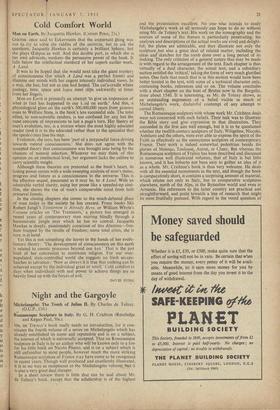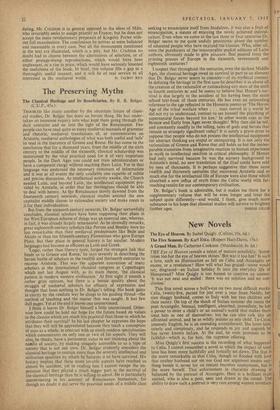Night and the Gargoyle
Michelangelo: The Tomb of Julius H. By Charles de Tolnay. (O.U.P., E10.) Romanesque Sculpture in Italy. By G. H. Crichton (Routledge and Kegan Paul, 50s.).
MR. DE TOINAY'S book really needs no introduction, for it con- stitutes the fourth volume of a series on Michelangelo which has already established its name and reputation and is on a subject, the interest of which is universally accepted. That on Romanesque sculpture in Italy is by an author who will be known only to a few for his little book on Nicolo Pisano, and is on a subject which is still unfamiliar to most people, however much the more striking Romanesque sculpture of France may have come to be recognised in recent years. Though well produced and excellently illustrated. it is in no way as sumptuous as the Michelangelo volume; but it is also a very great deal cheaper.
In a short review there is little that can be said about Mr. de Tolnay's book, except that the scholarship is of the highest and the presentation excellent. No one- who intends to study Michelangelo's work at all seriously can hope to do so without using Mr. de Tolnay's text. His work on the iconography and the sources of some of the themes is particularly penetrating; his analyses and descriptions of the actual works are vivid and delight- ful; the plates are admirable, and they illustrate not only the sculpture but also a great deal of related matter, including the d ideas and for the tomb done over a long period of its making. The only criticism of a general nature that may be made is with regard to the arrangement of the text. Each chapter is thus virtually of a dual character, the actual text, and a subsidiary section entitled the 'critical,' taking the form of very much glorified notes. One feels that much that is in this section would have been better treated in the text, with notes of a technical character only, containing books, references and so on. The volume concludes with a short chapter on the bust of Brutus now in the Bargello, done about 1540. It is interesting, as Mr. de Tolnay shows, as an outstanding expression of a belief visible in much of Michelangelo's work, disdainful contempt of any attempt to curtail liberty.
The Romanesque sculptors with whose work Mr. Crichton deals were not concerned with such beliefs. Their task was to illustrate the Bible story and give expression to that illustration. They succeeded in the first aim well enough, but it is to be questioned whether the twelfth-century sculptors of Italy, Wiligeline, Niccolo, Antelami and the others, were ever able to express the spirit of the Faith as effectively as the anonymous sculptors of contemporary France. Their work is indeed somewhat pedestrian beside the glories of Moissac, Toulouse, Autun, or Cluny. But whereas the Romanesque sculpture of France has been described and discussed in numerous well illustrated volumes, that of Italy is but little known, and it has hitherto not been easy to gather an idea of it as a whole. Mr. Crichton's book is thus very welcome. He deals with all the essential monuments in the text, and though the book is comparatively short, it contains a surprising amount of material, which relates not only to Italy, but to comparative sculptures elsewhere, north of the Alps, in the Byzantine world and even in Armenia. His references to the latter country are practical and straightforward, and point towards a line of research that might be most fruitfully pursued. With regard to the vexed question of dating, Mr. Crichton is in general opposed to the ideas of Male, who invariably seeks to assign priority to France; but he does not accept the more revolutionary proposals of Kingsley Porter with- out full examination. The conclusions he arrives at seem balanced and reasonable in every case. Not all the monuments mentioned in the text are illustrated, which is a pity; but Mr. Crichton no doubt had to choose between the alternatives of selection, or of either postage-stamp reproductions, which would have been unpleasant, or a rise in price, which would have seriously lessened the usefulness of the book. In brief, this volume fills a gap in a thoroughly useful manner, and it will be of real service to all interested in the medieval world. D. TALBOT RICE















































 Previous page
Previous page